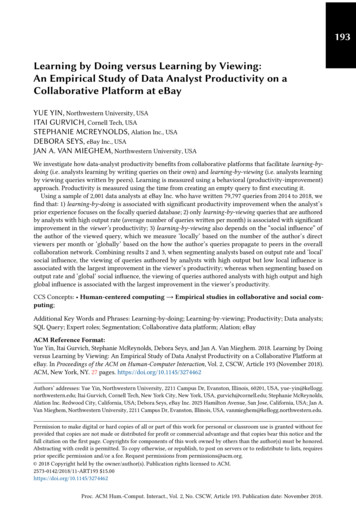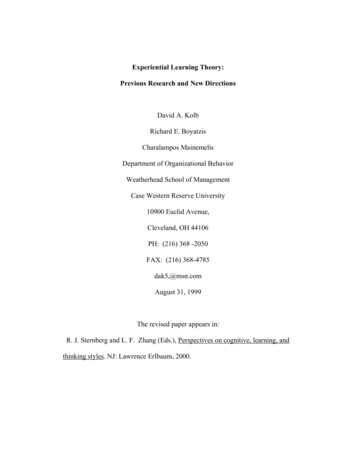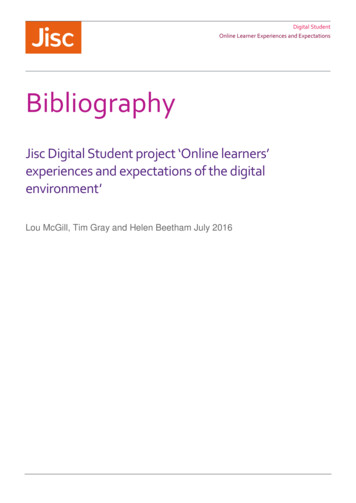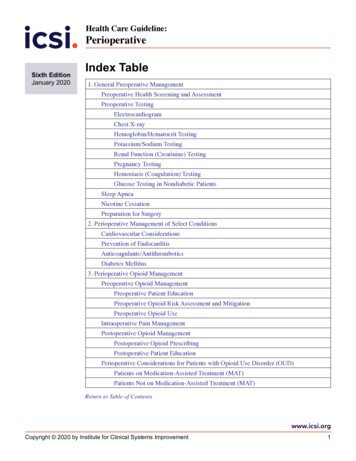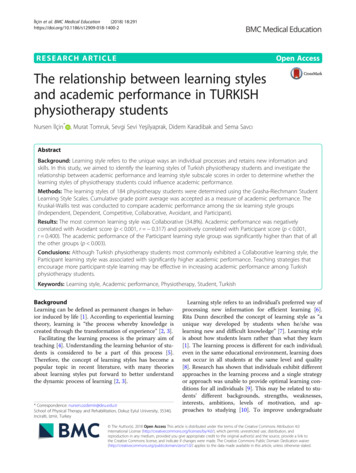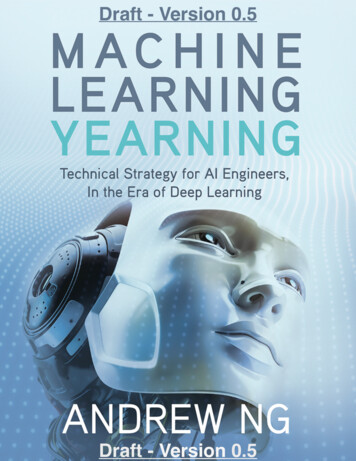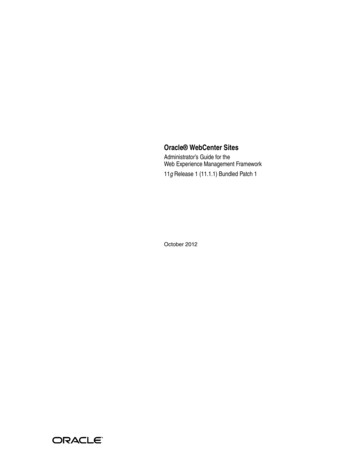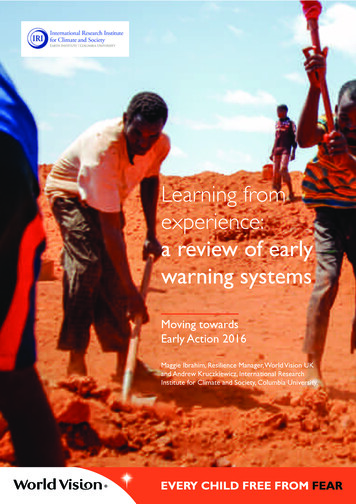
Transcription
Learning fromexperience:a review of earlywarning systemsMoving towardsEarly Action 2016Maggie Ibrahim, Resilience Manager, World Vision UKand Andrew Kruczkiewicz, International ResearchInstitute for Climate and Society, Columbia University.
Learning fromexperience:a review of earlywarning systemsMoving towardsEarly Action 2016Maggie Ibrahim, Resilience Manager, World Vision UKand Andrew Kruczkiewicz, International ResearchInstitute for Climate and Society, Columbia University.A review of Early Warning Systems3
Table of ContentsExecutive Summary14Section Four: Best Practice from External Agencies34Case Study One: United Nations Food Agriculture Organization (FAO)3411Case Study Two: Interagency Standard Operating Procedures – El Niño, La Niña35Why a review?11Case Study Three: Met Office (UK) – Impact Based Forecasting and Indigenous Knowledge36Structure of the Report12Case Study Four: Red Cross Red Crescent Movement - Forecast Based Financing37Methodology12Case Study Five: Start Network - Anticipation Window38Methods13Section One: Introduction and PurposeSection Five: FindingsOpportunities39A Holistic Approach3914Early Action Funding/ Contingency Funding40Weather and Climate14Capacity Building41Sources of Climate Information16Defining Success41Prognostic information16Partnerships for Information, Forecasts, Impact and Action Planning42Forecast Timescales16Barriers to translating Early Warning into Early Action42Historical: setting the baseline19Internal Barriers to Early Action43Current Information: understanding the significance of deviation from normal20External barriers to early action47Climate Information for EWS and Actions21Health and Climate Data21Definitions of Early Warning SystemsSection Two: Climate Information13Section Six: Conclusion and Recommendations for Effective Early Warning and Early ActionReferencesSection Three: Internal World Vision Experience4395122World Vision’s Rationale for Early Warning Systems for Early Action22Key Components of an EWS for EA – World Vision’s Experience22Case Study One: El Niño Southern Oscillation – Testing World Vision’s ability to act early26Findings27Case Study Two: From Famine to El Niño - Ethiopia 10 years of EWS27Case Study Three: SomReP: the cost of a disaster that didn’t happen30Conclusion33World Vision48Annex 1: Principles for Early Warning Systems and Early Action55Annex 2: Interview Questions55Contributors58A review of Early Warning Systems5
ExecutiveSummaryA review of Early Warning Systems (EWS) for EarlyAction (EA) is needed to improve World Vision’scurrent practice. This review focuses on EWS forslow on-set hazards in Africa. The methodology ofthe review consists of a threefold process: first, tohighlight perspectives external to World Vision aninternet-based key word search for EWS reviews wasconducted; second, World Vision were queried forreviews and document sharing; and third, interviewswere conducted with internal and external experts.Interviewees were identified from both a trust-basedchain-referral method and personal networking duringrecent EWS and risk reduction meetings, workshopsand conferences.In order to support the review of EWS, and inacknowledgment of the overarching role of climatein EWS, a discussion on climate data and informationis provided. In summary, various types of climate dataexist: forecasts, predictions, outlooks, projections andscenarios (Mason et al. 2015) are types that are mostrelevant to EWS. The three main characteristics of eachare: timescale; lead time and target period. Existenceand analysis of reliable historical data are necessary inorder to establish ‘normal’ conditions, which in turnare used to assess the magnitude of the extreme eventrelative to the defined ‘normal’. The skill (confidence)1of climate information is an important consideration asit may influence actions and user decision-making.Understanding the nuances of skill is an importantstep in developing an EWS. Some regions (centralSahara Desert region, for example) lack forecast skillregardless of season, while other regions experiencequite a significant shift in skill based on target seasonand lead-time. Skill of a forecast can change widely fromplace to place, meaning a forecast can be potentiallyvaluable for an EWS in eastern Kenya and not inwestern Kenya. Further, skill can change in a singlelocation if the lead-time changes and/or the targetperiod changes, for example a seasonal forecast inwestern Kenya for rainfall may be more valuable inOctober than June. Additionally, in western Kenya, anOctober forecast with a 1-month lead time (meaningissued in September) may have more skill than aforecast issued on a 3-month lead time (issued in July).From a practitioner perspective, it is important to beaware of the right questions to ask relative to shifts inskill (such as inquiring if a seasonal shift in skill occurs),in addition to inquiring if a region of interest simply hasskill or not.In the context of a climate-related sector-specificEWS, feasibility of a such a system is driven by boththe availability of a forecast that affords sufficient leadtime for appropriate preparedness actions (such asdistributing bed nets to prevent malaria, as a result ofhigh rainfall) and the assessment of skill of the availableforecast. A needs assessment is useful in determiningthe demand for particular actions, as well as thecapacity for various stakeholders to take those actions.Evaluating the socio-economic impact of takingaction, not only on depletion of funds and cost ofpotential disruptive impact, but also on risk perceptionof communities and other difficult to quantifysocioeconomic variables, is challenging and can lead toinconclusive results (Barnes et al. 2007). Quantifying theimpact of taking action based on a forecast when nodisaster occurs (acting in vain) is also challenging andremains a key barrier to evaluating impact. As a result,some agencies have adopted a ‘no regrets’ approach totaking actions based on uncertain climate information.‘No-regrets’ describes actions taken by households,communities, and local/national/internationalinstitutions that can be justified from economic,and social, and environmental perspectives whethernatural hazard events (related to climate change orother hazards) take place or not. ‘No-regrets’ actionsincrease resilience, which is the ability of a system todeal with different types of hazards in a timely, efficient,and equitable manner. Increasing resilience is thebasis for “sustainable growth in a world of multiplehazards” (Siegel, no date, retrieved 30 October 2016).There exists alternate schools of thought regardingthe definition of action ‘regret level’, with someorganisations considering actions with regret asthose actions that are important to consider. Actionsthat have regrets, such as evacuation, can often be ofhigh value if the hazard does occur. Therefore, manyorganisations advocate for the consideration of such‘potentially regretful’ actions when paired with anappropriately strong forecast. These regrets also reflectthe opportunity cost of taking action; the time andmoney used for any forecast-based action could haveachieved greater impact elsewhere if the hazard doesnot occur.Following a discussion on climate data and informationare case studies of EWS that have been developed16World Visionwith key agencies. These agencies include: World VisionInternational, World Vision Ethiopia, SomReP, the UnitedNations Food and Agriculture Organisation (FAO);Interagency Standard Operating Procedures – El Niño,La Niña; the Met Office United Kingdom (UK), theRed Cross Red Crescent Movement – Forecast-basedFinancing; and the Start Network (UK) – AnticipationWindow. The findings distilled from analyses of thesecase studies capture several opportunities and barriers.Opportunities include: developing holistic EWS for EAapproaches; setting up early action funding/ contingencyfunding with clear triggering mechanisms; buildingcapacity and strengthening partnerships for usinginformation, understanding forecasts, evaluating impactsand action planning.A holistic approach has been articulated by WorldVision and includes three key components: collectionand analysis of EW data; translation of EW data intoEA through information management and clearlydefined decision-making, systems and proceduresat each level, including monitoring and evaluation;and recommendations of early action for a range ofstakeholders.Holistic approaches to EWS for EA can includeexploring the potential to set up a reserve fund forpreparedness actions. This can be developed based onaction plans for high risks areas in collaboration withstakeholders and agencies (see case studies: FAO, RedCross Red Crescent Climate Centre – Forecast-basedFinancing). Accessing funding as a coalition has proven tobe successful (see case studies: SomReP, Start NetworkAnticipation Window) and could be an appropriatedirection to move towards as financing for developmentis increasingly prioritising outcomes at scale.The opportunity to build capacity for staff knowledgeof EWS and climate information has been establishedwith international structures, such as the GlobalFramework for Climate Services (GFCS), establishinglinkages between national meteorological/hydrologicalservices (NMHS), government ministries, privatesector actors, local level organisations and otherimplementing agencies (see case studies: World VisionEthiopia, SomReP, FAO, Met Office (UK)). Formalisingthese relationships is necessary to understand theavailability, access and use of climate information as wellas to agree on a coordinated plan of action linking keyIn this document confidence and skill are taken to have the same definition. High skill means high confidence.A review of Early Warning Systems7
stakeholders in country. Further, there is an opportunityto leverage recent work on outlining user priorities forclimate services to inform the goals for scaling up EWS(Vaughan et al. 2016).In addition to opportunities for implementing EWS,several barriers, internal and external, have beenhighlighted: 1) Culture of risk avoidance in the sector;2) A reactive operational model; 3) Insufficient financingfor early action; 4) Lack of decision making capacity;5) Projects designed for demonstration of short termimpact rather than sustainable institutionalisation; 6)Narrow focus on preparedness; 7) Weak informationmanagement and content; 8) Insufficient warninginterpretation at community level; 9) Missing guidancefor appropriate actions; 10) Focus on informationrather than utility; 11) Disagreement on EWS accuracyand appropriateness; 12) Missing health indicators andlack of cross sector coordination; and 13) Lack ofunderstanding coping strategies.The external barriers include: 1) Unclear rolesand responsibilities; 2) Media coverage; 3) Politicalconsiderations of affected countries; and 4) Politicalconsiderations of donor governments.Recommendations have been proposed to addressopportunities and tackle several of the barriers. Listedhere, these are not meant to define the necessarysteps for EWS development; rather, they are notedmore as guidelines and best practices. Many of therecommendations arise from the existing practicedetailed in the case studies. Identifying one’s startingpoint in taking up the recommendations should firstconsist of a review of current experience and existingcapacity in EWS design and implementation. Severalorganisations, as seen through the case studies, havekey elements in place already to build upon. Forexample, the SomReP approach is rooted in communityempowerment, therefore addressing, at least tosome extent, various recommendations noted here.Furthermore, EWS for EA is meant to link to andcompliment well established risk sharing approaches,such as social protection, pro-poor insurance andsavings groups. It is not a solution to tackling the driversof vulnerability but rather a system which can help toavoid disaster losses.Internal Barriers1. Culture of riskavoidance in the sector;2. A reactive operationalmodel;3. Insufficient financing forearly action;4. Lack of decision makingcapacity ;5. Projects rather cing;Capacity Building;Recommendations for Early Warning Systemsfor Early Action based on Case Studies Develop principles for EWS for EA to guide policies, focus investments anddevelop partnerships. Provide a separate funding stream for early action and routine data collectionand analysis. Use the rising evidence base to influence senior leadership/donorsperception of the cost saving benefit of pre-disaster investment, based on weatherforecast and climate outlooks. Work in coalition to seek funding for EWS for EA and manage risks of thedecision to act early. Explore capacity of climate expertise at national hydrological and meteorologicaloffices, and/or at regional centres for climate research/forecasting and developpartnerships. Design and update current EWS for EA in synergy with national hydrological andmeteorological offices and key stakeholders. Advocate for formalised agreementswith the met services, and support them in outlining climate risk and climateforecast information.8World Vision Embed EWS for EA into development programming and humanitarian responsethrough project models, national office strategies and programme design,monitoring and evaluation.7. Weak informationmanagement andcontent; Develop partnerships with key organisations, such as national meteorologicaloffices, FEWS Net and relevant ministries, for data gathering, analysis and actionplanning.8. Insufficient warninginterpretation atcommunity level; Involve community in risk analysis, action planning and feedback on successes andchallenges. Explore the potential for innovative approaches to link/engage acrossstakeholders.9. Missing guidance forappropriate actions; Identify context specific indicators through collaborative discussions with keysector experts and key partners and include conflict and health indicators to avertdisease outbreaks and violent conflict as well as increase coordination for actionplans.11. Disagreement onEWS accuracy andappropriateness;12. Missing health indicatorsand lack or crosssectoral coordination; Ensure timely, appropriate and verifiable information is shared with keystakeholders (internal and external partners) so that actions can be taken atthe right time. This requires partnerships with national met offices and externalagencies. Develop clear communication and dissemination systems tailored to keystakeholders – i.e. senior management, government, partners and communities.13. Lack of understandingcoping strategiesExternal Barriers1. Defining roles andresponsibilities Agree on a joint EWS led by the national government and on indicators andthresholds and on roles and responsibilities of different agencies. Develop pre-defined action plans based on agreed thresholds through crosssector discussions with both development and humanitarian experts. These canexpand on existing contingency plans. Build a holistic approach EWS for EA which includes decision-making, bridginghumanitarian, government and development departments. Build capacity of communities and staff and develop needed guidance to:understand climate and weather forecasts, understand and monitor current risksand develop cross sector early actions that can be taken up at the communitylevel. Include knowledge of EWS into job specifications and annual reviews -especiallyfor senior leadership and key personnel for ownership and accountability. Developa minimum standard for EWS knowledge.6. Narrow focus onpreparedness;10. Focus on informationrather than utility;Opportunities Use evidence base, including value for money, to showcase benefits for agenciesand communities which have acted early to fundraise and influence seniorleadership.g.2. Media coverage Build partnerships with media – international, national to local- to disseminateEW information and showcase achievements of early action, potentially identifyingactions taken and best practices in addition to reporting number of lives and/orfunds saved.3. Political considerationsof affected countries Work with relevant ministries to develop coordination as well as informationsharing through standard operating procedures and memorandums ofunderstanding.4. Political considerationsof donor governments Organise field trips for key politicians to see EWS for EA activities underway andhighlight cost savings that can be shared with their electorate. Promote inter-governmental peer-to-peer learning.A review of Early Warning Systems9
Section One:Introduction and PurposeWhy a review?EWS for EA have been similar improvements in practiceacross a range of agencies.With the increase in frequency of disasters and betterinformation systems, there is a need and opportunity toimprove early warning systems for early action (EWSfor EA) that enables World Vision to reduce exposureof risks faced by children and their families. A realchallenge is the lack of robust evidence on what aneffective early warning system looks like at the differentlevels of action.Despite this range of experience, there remains alack of clarity and agreement at different levels ofthe organisation of what is currently needed froman effective EWS, which level (s) it should operate atwithin the organisation and how best to ensure anyEWSs developed are contextually appropriate, efficientand effective for early action.One of the main drivers for a review of defining EWSwas the 2011 failure of agencies, donors and theinternational community to prepare and respond tothe Horn of Africa drought crisis and famine in Somalia(Hillier and Dempsey, 2012).Retrospective analysis found that climate information,such as forecasts for below average rainfall and currentmetrics of vegetation departure from average, coupledwith analyses of pre-existing socioeconomic conditions,could have been used to promote early action beforethe drought occurred (Hillbruner & Moloney 2012).Underscoring not only the need for timely information,but for appropriate action to be taken that would savelives and livelihoods before a crisis, a range of actorsbegan to increasingly use the term, ‘early warning, earlyaction’ to define EWS.Further outlining the need for EWS, the cost fordelayed action has been recognised (Catham house,2012) by humanitarian organisations (Coughlan dePerez et al. 2016) as well as donors. The UnitedKingdom Department for International Development(DFID) commissioned cost benefit analysis throughresilience measures in Kenya and Ethiopia to ascertainthe case for early action (DFID, 2012).Since 2006, World Vision has been active inimplementing early warning systems. This has evolvedfrom a focus on food security in Ethiopia to a multihazard EWS in both the Eastern and Southern Africanregions. Most recently, World Vision’s EWS has beentested by the recent 2015 El Niño which has severelyimpacted communities across Central America, EastAfrica (particularly Ethiopia), and the Pacific andSouthern Africa. Furthermore, World Vision has morethan ten years experience in building resilience throughdisaster risk reduction and climate change adaptation(Carabine et al., 2015) and has actively contributed torelated policy dialogues on reducing risk and promotingEWS through the Sendai Framework for Disaster RiskReduction. Alongside World Vision’s evolution of itsThe purpose of this reviewis to: Provide learning from World Vision’s andexternal agencies’ practices on early warningsystems (EWS) Inform World Vision’s early warning steeringcommittee of findings and recommendationsin order to inform a EWS for EA roadmap toimprove practice.The findings will be shared and discussed with theWorld Vision EWS steering committee and sharedexternally.Structure of the ReportThe structure of the report is aimed to providereaders quick access to experiences, findings andrecommendations. As such, is it divided into fivesections.Section one, the introduction, includes an executivesummary. This provides a condensed summary of theinternal World Vision and external agencies experiencesin EWS, findings and focuses on the recommendationsbased on the evidence. The introduction also includes:the purpose of the report the methodology applied, anda short discussion on the definitions of early warningsystems and the evolution of the term to now includeearly action. Section two, provides overview of thedifferent types of climate information that is currentlyavailable and their uses. It also highlight challenges ofclimate data and delivering timely actions.towards case studies and learning reviews based onslow onset hazards. The first is a case study of WorldVision’s recent 2016 experiences responding to ElNiño. The second case study is from Ethiopia chartingits progress and learning from 2006 to the recentexperience to acting early to the impacts of El Niño in2016. The third case study includes experience fromthe SomReP consortium in Somalia over the past fouryears.Section four of the report gathers best practices onEWS for EA from a range of external agencies. Casestudies have been developed based on exchanges withexperts from the following agencies: the United NationsFood and Agriculture Organisation (FAO); InteragencyStandard Operating Procedures – La Niña; the MetOffice, the Red Cross Red Crescent Movement –Forecast-based Financing; and the Start Network.Section five of the report analyses these experiencesfrom the internal World Vision practise and externalagencies into principles for EWS for EA, opportunitiesand internal and external barriers to effective EWS forEA.Section six responds to these opportunities andbarriers by suggesting recommendations based on thefindings in the evidence sections two and three andincludes a list of top recommendations to considerfor World Vision’s EWS for EA. The section includes aconclusion highlighting key recommendations and nextsteps for World Vision International.MethodologyThis review will focus on EWS for slow onset hazardsin Africa in order to narrow the scope of the study.The implications of this are: lessons will be based onforecasting for slow onset hazards rather than rapidonset hazards such as earthquakes, hurricanes andtyphoons. If this review proves to be of great value, itcan be adapted for rapid onset hazards in other regions.Consideration of the linkages of the health sector andlivelihoods are included as health is often absent fromEWS.For the purpose of this review on EWS for EA anddisaster preparedness based on climate information,data was collected through a number of qualitativemethods. In order to separate out traditional disasterrisk reduction preparedness activities from EWS, theuse of weather/ use of forecast/seasonal outlooks inconjunction with risk assessments will be used.World VisionThe methodology used to conduct this review isthreefold. External and internal reviews of EWS forEA were conducted as were interviews of key internalinformants and external experts.For the external review, 3 methods were employed.First, a boolean google search of reviews of EWSwas undertaken using key words and terms: earlywarning system*; disaster preparedness; feedbackmechanisms; community response; community decisionmaking; and end to end decision making. In addition,requests for information sharing on EWS reviewand experience were sent to the Start NetworkAnticipation group and the OCHA Standard OperationProcedures Rome Drafting group. Together, thisresearch request has reached more than 30 nongovernment agencies working in forecasting as well asUN institutions. Additionally, attendance to the WorldBank’s Understanding Risk Conference2 presented theopportunity to explore the latest thought in EWS. Achain-referral method from the conference to gatherfurther information from key actors met was achieved.For a review of internal World Vision experience inEWS, World Vision International (WVI) personnelwere polled through email. First, a request was sentto World Vision Resilience & Livelihoods CoP (over2000 members) for examples of project documents orreviews that include preparedness at local level basedon weather information (time, rainfall, hydrologicalinformation); and National Office early warning systems.In addition, WVI Humanitarian Operations SeniorDirector - Francois Batalingaya – sent a request tothe World Vision Humanitarian Emergency CoP andHumanitarian Emergency Regional Directors for projectdocuments or reviews that include: preparedness atlocal level based on short to medium range (hours to14 days) weather information (time, rainfall, hydrologicalinformation) and reviews of World Vision NationalOffice early warning systems.A chain-referral method was used to identify key WorldVisions staff to interview as well as external experts.A maximum of 15 interviews could be conducted. Theinterview questions are included in Annex Two.Section three of the report focuses on WorldVision’s rationale for EWS for EA. It then provideskey components of an EWS. The section then rogram/A review of Early Warning Systems11
Definitions of EarlyWarning SystemsA clear definition of EWS by World Vision was neededto begin the research process. A review of the literaturehighlights that there are a variety of definitions forEarly Warning Systems. According to UNISDR (2009)terminology, EWS are defined as:The set of capacities needed to generate anddisseminate timely and meaningful warninginformation to enable individuals, communitiesand organizations threatened by a hazardto prepare and to act appropriately and insufficient time to reduce the possibility ofharm or loss.Comment: This definition encompasses therange of factors necessary to achieve effectiveresponses to warnings. A people-centredearly warning system necessarily comprisesfour key elements: knowledge of the risks;monitoring, analysis and forecasting of thehazards; communication or dissemination ofalerts and warnings; and local capabilitiesto respond to the warnings received. Theexpression “end-to-end warning system” isalso used to emphasize that warning systemsneed to span all steps from hazard detectionthrough to community response.12World VisionIn Reducing Disaster: Early Warning Systems ForClimate Change (Singh and Zommers, 2014), it is shownthat a single definition does not exist with doubt foragreement on a universal definition in the future. Theysupport the UNISDR’s 2009 definition and underscorean EWS being a social process aiming to avoid thehardship caused by natural hazards.The term Early Warning, Early Action has beenincreasingly adopted by practitioner organisations.In 2008, an IRCR publication, “Early Warning, EarlyAction” (ICRC, 2008) highlighted the principles of anEWS that would lead to early action. Other agenciessoon followed with UN agencies, such as FAO, IASCand World Organisations, such as WMO adopting theterm. UK NGO practitioners working in the field ofhumanitarian response and development have alsobegun to use the term (i.e. Start Network). In thesecontexts, the terminology surrounding early warningsystems (EWS) and early warning and early action(EWEA) are centred around social processes thatlead to decision making to prepare and respond to acertain natural hazard. It is the social processes thatare explored in the review below, alongside the keyelements of an EWS for Early Action (EA).A review of Early Warning Systems13
Section Two:Climate InformationWeather and ClimateWhile at times used interchangeably, weatherand climate have distinct meanings. Both refer toatmospheric conditions, with weather describingconditions at a particular place and location and climatedescribing how the atmosphere behaves over longperiods of time at a particular location or over regions(NASA, 2005). A quote sometimes attributable to authorMark Twain notes the difference as, “climate is what youexpect, but weather is what you get”.For a depiction of climate and weather in Africa, figure1a indicates the location for Blantyre, Malawi, whilefigure 1b is a bar chart showing the monthly distributionof rainfall there. This historical climate information is aclimate descriptor and is calculated by taking the meanmonthly precipitation value from many years (in thiscase, 1971-2000) (IRI Data Library, accessed 2016).From this analysis, we can glean a shift in precipitationacross seasons (as noted by the change in heights ofbars, which is indicative of different mean monthlyprecipitation levels). As an example, in January onecan conclude that approximately 200 mm of rainfallis expected. This conclusion is based on what wasexperienced in previous Januarys and while it is assumedan exact amount of 200 mm is unlikely, 200 mm is thevalue that can be expected. As this is the expected value,per historical records, it is likely that communities inthis region have developed resilience to this amountof rainfall. However, the temporal (daily) distribution14World Visionof the rainfall is important considering shifts in risk. Forexample, it can be assumed that the 200 mm of rainfalldoes not occur in one day, and is distributed at leastpartially over the 31 days of January. Perhaps if 200mm(or more) occurs in one or a few days, resilience may bedecreased and impacts in terms of flooding could possiblybe expected. Fluctuations in both timing and quantity ofprecipitation are most important to account for in areaspredominantly relying on rain fed, smallholder agriculture.precipitation (mm/month)An EWS, as an example of a climate service, shouldconnect climate information to decision making,supporting various modes of climate risk management(Vaughan et al. 2016). Climate information is likely to bea valuable component of an EWS, however if integratedwithout proper scrutiny, it could deem the EWS useless.Foremost, in the context of an EWS, climate informationmust be available on appropriate timescales relativet
Action (EA) is needed to improve World Vision’s current practice. This review focuses on EWS for slow on-set hazards in Africa. The methodology of the review consists of a threefold process: rst, to highlight perspectives external to World Vision an internet-based key word search for EWS reviews was

